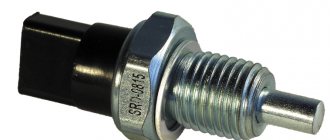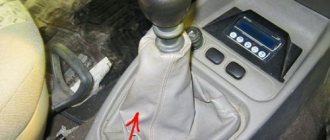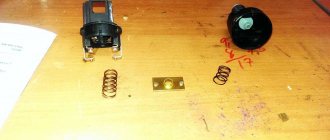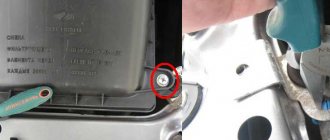Hi all! Reversing with non-working lights, especially at night, can be fatal for the driver of a faulty car and the cars moving behind. You need to understand that if the reverse light is not on, this is a serious problem that needs to be fixed.
The only question is to find the reason for such a situation. If the car's reverse light suddenly stops working, it is recommended to immediately begin diagnostics.
There are several potential problems. Once you find out exactly why the light does not turn on, you can take appropriate measures to eliminate the problem.
Possible reasons
If the reverse lamps do not turn on when shifting into reverse gear, whether it is manual or automatic, you need to look for the reason.
The light must be on. This will not only result in a fine, but can also lead to a serious accident or accident.
- Sensor malfunction. It is also a reverse switch, limit switch or frog. This controller is quite reliable and durable. But still, the possibility of its breakdown cannot be ruled out. Especially if the car was hit from behind, the headlight was broken and the lights were changed;
- Burnt out light bulb. Or maybe everything is outrageously banal. Over time, the light bulb has used up its resource, and therefore no longer works. It will have to be replaced;
- Fuse. Also, the signal may disappear if the sensor responsible for these lights burns out. This is a fuse link that burns out when the permissible voltage is exceeded. Since this fuse is responsible for several devices at once in most cars, in parallel with the reverse gear, other lamps, dashboard lights, etc. may not light;
- Open circuit. Here pins can break off, wires can fray, and more;
- Oxides and corrosion. Formed in places where the contacts of the circuit leading to the rear lights are connected;
- Ground contact. If the ground is bad, reverse gear may not function. This is also one of the reasons why the brake lights on a car do not light up.
Unlike the situation when the lamp is constantly on, there are many more potential causes.
But still, the most common problem is the failure of the reverse switch. It is also called a frog.
Reviews
| № | Positive |
| 1. | Dmitrievich (drive2.ru): there are no complaints about the sensors and devices on the Lada Vesta, they work as normal. |
| 2. | Semyon (prom.ua): The “toad” served for three years, after which it broke and was replaced with a new one. |
| 3. | Sergey (drom.ru): mileage 55,000 km. There are no comments on instruments or sensors. |
| 4. | Konstantin (rozetka.ua): I bought a new “sensor” from Lada Kalina, they are interchangeable with Lada Vesta, but the price is 15% cheaper. |
| 5. | Vladimir (Auto.ru): “Sensor” works normally, there are no complaints about the functionality. |
| 6. | Nikolay (auto.mail.ru): the contact on the end switches loosened a little, I pressed it with pliers. The "sensor" operates normally. |
| 7. | Kirill (drive2.ru): I can’t say anything special about the “sensor”, they work properly. |
| 8. | Sergey (drive2.ru): in three years of operation of the car I have never changed the DZH. |
| Negative | |
| 9. | Vladimirovich (prom.ua): at 35,000 km I replaced the “toad”, suddenly the “sensor” failed. |
| 10. | Alexander (Bibika.ru): in the second year of operation of the car, the auxiliary switch jammed, I went to the service station to have it replaced under warranty. |
| 11. | Valentin (drive2.ru): The DZH works intermittently, it is unstable, I will screw in a new one. |
| 12. | Semyon (Avtodispatcher.ru): after the winter the “sensor” jammed, the lighting does not turn on. |
Location
The location of the switch or frog largely depends not on the make and model of the car, but on the transmission with which the vehicle is equipped.
If it is a manual transmission, then the switch will be installed directly on the gearbox housing. When reverse gear is engaged, the switch button is pressed, the frog contacts are bridged, and current flows to the rear lights.
As for automatic transmissions, instead of a standard limit switch (frog), a selector position sensor is used. Depending on the change in the position of the automatic transmission handle, the corresponding signal is transmitted to the power unit control unit, which transmits it to the unit that controls the light.
Checking the functionality of the sensor
Replacing the fuse is not difficult. But checking the condition of all wiring, ringing it and replacing it if necessary is a much more difficult task.
If we talk about restoring the functionality of the reverse lamps with our own hands, then we mainly have to deal with the switch.
To check it you need to do the following:
- remove the rear lamp switch chip;
- turn on the ignition;
- Using a piece of wiring, close the contacts of the sensor and the reverse gear to each other.
If at the same time the lamp lights up, then the reason lies directly in the limit switch.
In this situation, the simplest and most logical solution would be to replace a completely faulty sensor. Indeed, on many cars, replacing it is impractical, too complicated and virtually useless. It is not always possible to restore the functionality of the device. Although there are a number of examples when the sensor was simply disassembled, the contacts were cleaned, and everything returned to normal operation.
It is very difficult to say how long the restored switch will work. This could be for many years, or just a few days.
If everything is fine with the frog, then you will have to ring the circuit and look for the area where the voltage disappears. For these purposes, you will need to use a test light or a multimeter. The task is not for beginners, since we are talking about electrical circuits and working with car electrical systems. Here, for many, it will be more profitable and safer to turn to specialized specialists.
Checking the relay
Where is the Grant turn signal relay located? Everything is in the same mounting block. Marking K5.
How to replace the turn signal relay on a Lada Grant? It can be removed using a puller located in the mounting box, and then a known-good unit can be placed in the free space. If everything works with the new relay, then the problem is solved. However, even before searching for a burnt-out lamp, you can check the Lada Granta turn signal relay.
If you are faced with the fact that the turn signals on your Grant are constantly on, then this probably indicates that something is shorting somewhere. You need to test the circuit with a multimeter. Sometimes in this case it is possible to establish the influence of emergency lights and even signaling. Remember if you changed anything there before the problems with the turn signals appeared.
Another common problem is the situation when the turn signals on a Lada Granta do not work, but the emergency lights do work. It is necessary to check whether everything is in order with the emergency button. It happens that the button simply moves away. It needs to be given a normal position, and the turn signals will work.
Summing up
A reverse light that doesn't come on is just as potentially dangerous a problem as a reverse light that stays on all the time, even when the car is moving forward.
Therefore, such a problem cannot be ignored under any circumstances. Just like installing a flashing brake light for the sake of beauty. It may look impressive, but it confuses drivers significantly.
In some cases, you can find and eliminate the cause yourself. And without any problems. But there are also situations when the best solution is to visit an experienced auto electrician.
I have a Granta liftback and at some point both lights stopped coming on when I engaged reverse gear.
It is too stupid to think about burnt out lights, 2 lights cannot burn out at the same time, which means there may be a fuse or a reverse sensor on the gearbox.
I recommend starting diagnostics with the fuse:
Fuse F6 is responsible for the reversing lights. Pull the fuse and see if it's blown? I think it's unlikely to burn out. But it's worth checking.
If the fuse is intact, then the problem may be with the sensor. But this can also be checked.
First, the sensor on the 2181 box (cable box) is located above it, unlike the old box, where the sensor was below.
The sensor is located directly above the box. If you look at the box under the hood, you will see it. There are no options here.
Secondly, we remove the chip from the sensor and close the contacts with a regular paper clip:
Next, turn the ignition key and go look at the rear lights. No need to engage reverse gear 
Are you on fire? That's it, it means the problem is in the sensor, which means it needs to be changed.
To replace the sensor, we need the sensor itself and a key for 22. I had this regular key:
And of course you need the sensor itself:
Sensor marking: 2190-3710410. In the photo above is the original sensor that was installed on the 2014 Lada Granta liftback from the factory.
I go to the store and buy such a sensor with the inscription “OTK” for 85 rubles. Thanks to VAZ for the fact that all these sensors are available in any store and you don’t have to wait weeks for delivery.
Installing the sensor is simple: unscrew the old sensor, screw in the new one, and put the chip in place. There is a copper ring under the sensor, don't lose it.
Do I need to remove the air filter? Everything depends on you. I was able to reach right under the filter with my hands and rip off the sensor. Why rip it off? Because it is very twisted, be prepared for it.
Reversing at night will be a real challenge if the car's reverse lights are not on. Let's look at why the lamps stopped burning and methods for independently searching for the root causes. Most likely, knowing how to test the reverse light switch will be the most useful skill when troubleshooting.
Main reasons
- The fuse has blown. Both lamp bulbs are protected by one fuse link. Together with the lamps, the fuse will most likely protect some other circuits. Therefore, if your car’s taillights not only stop lighting, but also, for example, the dashboard backlight does not work, the first thing you need to do is check the fuse. You can find out which “socket” in the mounting block the lamp circuit goes through from the repair and operating manual for your car. In many cases, the main circuits are shown graphically on the inside of the fuse box cover.
Instead of a burnt-out insert, install only a fuse of the same rating. Installing a fuse link with a higher rating may cause the vehicle to catch fire. You can familiarize yourself with all the selection rules in the article “Classification of fuses for cars.”
- Limit switch faulty.
- Open circuit (breaking off pins in connectors, chafing wires).
- Formation of oxides, corrosion at the junctions of contacts, burning of pins.
- Poor ground contact of the lights. In case of problems with the general “mass”, brake lights and turn signals may also not work. It is extremely unlikely that both bulbs stopped lighting at the same time due to contact problems in the lanterns. But a bad ground can cause the reverse gear light to not light up on only one side. Of course, in this case it is worth checking the lamp itself.
Checking the serviceability of the fuse
This is the next stage of action when the turn signals of the Lada Grant do not work. Now open the mounting block. It is located on the left side of the dashboard. There you will find 32 fuses. For standard cars, the fuse we need is marked F6, which also serves the reversing light.
A malfunction is determined by a burnt-out hair, but it is not always possible to confine yourself to just a visual inspection. Therefore, you need to replace it with a new one. If the old one was faulty, then it is necessary to check the entire circuit (after all, it didn’t just burn out). To do this, you will need a multimeter or a test lamp. For example, the right turn signal of the Lada Granta does not work. You need to ring all the bulbs in this circuit and find a short circuit. The next step is Lada Granta turn signal relay.
Place of the switch in the light switching circuit
On cars with manual transmission, voltage to the lamps when reversing is supplied through a limit switch (the so-called frog), which is screwed directly into the gearbox housing. When reverse gear is engaged, the switch button is pressed inside the gearbox. The contacts inside the “frog” bridge, and current begins to flow to the lamps.
On the circuit diagram for turning on the reversing lights, we can see that on the VAZ 1118 Kalina, the current from the battery through the ignition switch (No. 2) is supplied to fuse F1. Passing through the fuse that protects the switching circuit, “+” goes to the limit switch (No. 10). The contacts are in a normally open state and close only when reverse gear is engaged. Thus, current begins to flow to the light bulbs. The second contact of the lamps is connected to the “–” battery through the common ground contact of the lamps.
On cars with automatic transmission, the role of the limit switch lies with the selector position sensor. Information about changing the location of the gearshift knob is transmitted to the engine ECU, the light control unit.
How to check the "frog"
- Remove the headlight switch chip.
- Turn on the ignition.
- Using a small piece of wire, connect the contacts of the reverse gear sensor connector to each other.
If the reverse lights are on, then the problem is in the “frog”. Some drivers disassemble the switches, clean the contacts, after which the device continues to work properly. It is up to you to judge the appropriateness of such measures. But keep in mind that on many cars (including VAZ models) the limit switch is located below the oil level in the gearbox. We recommend simply replacing the power sensor. To minimize oil loss, jack up the car on the side where the end switch is installed.
On some cars, the reversing lights do not light up due to incomplete activation of the limit switch. The problem can be solved by installing a thinner washer under the “frog”. To make sure that the switch is working, check with a multimeter in ohmmeter mode whether the contacts close when you press the button.
Checking the circuit
The essence of diagnosing the reason why the reverse lights do not work comes down to identifying the section of the circuit where the voltage is lost. To do this, you can use a regular control light. Continuity testing is done with an ohmmeter, so you need to know how to use a multimeter.
You can start checking directly from the limit switch connector. Turn on the ignition. Connect one contact of the control light to an unpainted metal part in contact with the body, and the second to the “+” connector.
- If power comes in, check the reverse sensor.
- If after installing the “jumper” in the connector the lights do not light up, then the problem is in the section of the wire circuit going from the connector to the lights. Ring the wire to the point where it divides into light bulbs on the left and right sides. Most likely, the reason is the break.
To find the pinout of connectors, light contacts, and wire colors, be sure to study the electrical diagram of your model and vehicle configuration.
The lamps are constantly on
If the lights on your car are constantly on or come on regardless of whether reverse gear is engaged, the cause will be among the following breakdowns:
- short-circuiting the “+” going to the reverse gear sensor and the light bulb wires from the switch;
- the wire going from the connector to the lights has a short to “+” (this happens if the wires in the harness fray);
- The sensor is stuck in a closed state.
Malfunction of reverse lights on VAZ 2114. Maintenance and prevention
Reversing lights for VAZ 2114
What are reverse lights? These are white road lights that turn on in reverse gear, guaranteeing safety while driving. If the reverse lights are not on, then the possibility of the driver getting into an emergency increases; it is very difficult to park in the dark when the road is not visible, and passengers will not be able to predict the actions of vehicles, which can lead to unpleasant consequences.
The frog signal device is a necessary device. As they say “in the language of a motorist”: everything that is in the car must function properly, the safety of vehicle traffic depends on it!
So, at the slightest breakdown or short circuit of the reverse light, you need to immediately begin repairing it. This can be done both at service stations and at home, quickly and very simply. And this theoretical basis will be a great help!
Video.
Did you like the article? Follow our channel for new ideas of useful car tips. Subscribe to us in Yandex.Zen. Subscribe.
During operation, maintenance and minor repairs are required, which makes it at least unreasonable to go to a car service center. In this review, we will look at how to change the low beam bulb on a Grant, plus we will figure out how to troubleshoot some problems and how to adjust the position of the headlights without outside help. After reading the information below, you will see for yourself that there is nothing complicated in all this work.
Removing the backplane board
First you need to remove the rear lights on the VAZ 2114, and for this you will need:
- Open rear trunk
- Remove unnecessary things
- Remove decorative trim
- Unscrew the plastic casing
- Take out the back panel
Now you have access to the socket and lamp of the rear license plate lamp, which also needs to be removed. The frog mounting pins are removed and the flashlight is already in your hands. The main thing is not to confuse it with the speed sensor, which is also located on the gearbox.
When you engage reverse gear, the instrument panel fuse lights up.
December 10, 2011, 22:55 #1
When you turn on the rear, the light in front of the dashboard lights up, the turn signals and reverse lamps do not work. Only the backlight works. how to be.
December 10, 2011, 10:58 pm #2
What kind of car?
December 10, 2011, 11:17 pm #3
December 10, 2011, 11:20 pm #4
Maxut, December 10, 2011, 23:17, #3
Offhand, the frog was not checked at the checkpoint. Maybe it's shorted? Is fuse F 16 lit?
December 10, 2011, 11:28 pm #5
this fuse, where is the frog located?
December 10, 2011, 23:35 #6 + 1
Maxut, December 10, 2011, 23:28, #5
this fuse, where is the frog located?
On the box is the reverse light switch. There should be two wires going to it
How to check the functionality of the frog?
The contacts from the sensor are removed and clamped together, after which the ignition is turned on. If there is light, then you need to replace the sensor. And if not, then the problem is in the circuit, but the frog is fine.
When the reverse lamp does not light up, it is often necessary to replace the old sensor with a new one.
What should be done:
- place the car on the overpass;
- install the handbrake;
- remove protection;
- remove the contacts of the old sensor;
- place the container and remove the frog;
- Unscrew the faulty device and replace it with a new one.
Then let it sit for a while and check the oil in the gearbox. Fill it up to the required level and put the entire structure back together.
Attention, the price of a new sensor is within 250 rubles.
The next option is if the reverse light does not light up on a VAZ 2114, then the problem is in the light bulb. To replace it, you need to disconnect the wiring block, remove the plastic contact panel from the flashlight, while squeezing the side fixing elements.
We rotate the light bulb counterclockwise and, pressing slightly on the socket, remove it. Now we install a new one, check the contacts and put the entire unit back together.
We visually assess the condition of the wiring; if necessary, we strip the wires, check for breaks using the ringing method, and check the contacts on the headlight film.
Why aren't the reverse lights on yet?
A blown fuse is a common cause, which means you need to know exactly where they are located and how they change.
The products are located in the fuse box, which can be found under the steering wheel on the left side. It can be easily removed with just one touch of your hand. There is no need to unscrew anything.
When the reverse light does not light, you need to check the condition of the fuses. How to do this? You can visually look at the fuses and determine the breakdown - the integrity of the middle part.
But the burnt jumper is not always so clearly visible, so you need to turn on the dimensions and, without removing the fuses, check the voltage; if one end is on and the other is not, the device is faulty.
Attention: when such a breakdown often occurs, you need to check the entire electrical wiring system, which causes such malfunctions in the car.
To replace the product, you don’t need tools, just take tweezers, remove the old unit and install a working one.
Key conclusions and recommendations from professionals
You can find out where the VAZ 2114 reverse sensor is located very simply by looking up at the gearbox, and if the driver cannot get under the car, then the hood opens and thus the condition of the frog is checked.
To completely verify that the brake gearbox is damaged, you need to turn the wheels to the left and look at the gearbox from the driver’s side. There is a protection with contacts inside on the side, remove it, close the contacts on the DZH and turn on the ignition. When everything is in order, a white light appears.
If not, then use a tester to measure the voltage on ground and on the orange wire that comes from the frog. If voltage is present, then we check the flashlight board itself and clean the contacts.
There is also a chance that the contact between the frog and the fuse block has “frozen”; you need to find it and check its condition.
Attention: when everything is normal, but the lights do not light, the reason may be the contact of the lamp, so even when screwing in a new one, you must check its functionality. As the people say, it’s no joke, because a breakdown can be the easiest, but it can lead to a lot of troubles.
This is why the reverse light on the VAZ 2114 does not light up, as you can see, there can be many reasons, and for the motorist it is important to carefully check the integrity of all frog mechanisms, identify the malfunction and repair the functionality of the lighting.
Have a nice journey, good fellow travelers and a smooth road!
Most fuses are located in the mounting block inside the car. The serial numbers of fuses and relays are indicated on the housing of the mounting block. The purpose of the relay and the circuits protected by fuses are indicated by symbols on the inside of the instrument panel trim, which covers the location where the fuses are installed. The current strength for the fuses is also indicated there. Additional relays can be installed to the left of the Lada Granta mounting block.
Cars VAZ 2190, VAZ 2191 - 2011, 2012, 2013, 2014, 2015.
Cars Lada Granta Liftback, Granta Luxury, Granta Standard, Granta Norma were also considered.
Where is the mounting block located on the grant?
In the cabin. The fuse and relay mounting block is installed in the instrument panel on the left side.
1. Pull and remove the instrument panel trim
2. Using the number on the inside of the trim, we find the fuse for the faulty circuit.
3. Using tweezers, remove the faulty fuse
Sometimes the fuse thread remains intact, while its connection inside the fuse is broken. It is impossible to visually determine such a malfunction. In this case, you can assess the condition of the fuse using an ohmmeter or a test lamp.
Layout of fuses and relays in the mounting block.
Interpretation of fuses and relays in the mounting block of the Lada Granta.
Circuit breakers
Electronic engine control unit, cooling fan relay, fuel injectors
When reversing, the driver must monitor the situation behind his car. The Lada Granta's reverse sensor allows you to notify road users that the car is starting to move backwards. When the gearbox selector is turned to the “R” position, the headlight sensor turns on the light; as soon as the driver engages forward gear, the light turns off.
Principle of operation
It is not difficult to understand the operation scheme of the DZH. It is located in the gearbox and uses a switch at the end. When the gearbox selector moves while changing gears, the switch is either pressed or released, depending on the gear engaged.
If the sensor stops working, then the headlight, which indicates the beginning of backward movement, either stops turning on or begins to work incorrectly. The reasons for the malfunction of the DZH can be different:
- Lamps are burnt out or broken;
- The fuse has blown;
- Block contact failure;
- Oxidation of contacts.
Functionality check
It is checked in the most primitive way. To do this, you need to disconnect the wires from it and connect them directly to each other. After this, you need to turn on the ignition and switch the gearbox selector to reverse speed. If the headlight starts to light, then the fault is in the DHZ; if the light does not start to light, then the problem is somewhere else. It is also possible to connect a light bulb or sensor to another electrical network and check using it.
In order to check the sensor, you need to prepare a multimeter. It is necessary to check the voltage on the ground, as well as the orange wire that is connected to it. If voltage is present, then you need to ring the entire contact group from the fuse block to the gearbox. If there is no voltage, then the problem is in the DZH itself.
Burnt out lamps
One of the most common problems is a burnt out lamp. To check this, remove the light bulb from the holder and connect it to the battery terminals with a short wire. If the light comes on, then the fault must be looked for at another point in the electrical circuit.
First, check that the light bulb socket and electrical terminals are clean and bright. If there are any signs of corrosion, clean the socket with wet and dry paper, then reinstall the bulb and retest.
A burnt out light bulb is the most common cause
If the reverse light still does not come on, the fuse may have blown. Also, everything indicates a blown fuse if two reversing lights are constantly on. In this case, a replacement will be needed. Fortunately, getting to the fuse box where they are located will not be too difficult for you.
Replacement
If it malfunctions, it is necessary to diagnose and, if possible, replace it. To do this, you need to know where the reverse sensor is located on the Grant. To get to the DZH, you need to dismantle the crankcase protection. Before dismantling the old DZH, it is necessary to prepare containers, a rag and oil for the gearbox. After the crankcase protection is removed, we bring the container to the ESD and unscrew it. Oil will leak from there, so you need to quickly screw the new sensor into place. After this, the wires are connected to the new ESD, and oil stains are removed with a rag. When the replacement is complete, it is better to check the oil level in the gearbox and top it up if necessary.
Useful Tips
If your vehicle's reverse lights do not come on, check the electrical circuits and the switch sensor located on the transmission housing or automatic transmission switch. The use of flashlights is not regulated by traffic laws, but the effectiveness of flashlights depends on how you can maneuver safely in the dark.
Purpose
Obviously, the car's reverse mode is designed to accelerate the car in the opposite direction without resorting to a 180-degree turn. This allows you to park more comfortably, maneuver faster and, finally, save time for yourself and other drivers.
A reverse signal is needed to warn surrounding drivers of an upcoming maneuver, similar to the way turn signals or brake lights do, embedded in the taillights.
Thus, when reverse gear is activated, a white lamp lights up. All drivers and pedestrians behind are instantly informed that the driver plans to reverse and make decisions about their further maneuvers.
The reverse alarm is also intended for maneuvering in the dark and in fog. The lamp, which has a fairly powerful light beam, allows the driver to better see what is happening behind the car and avoid annoying accidents and incidents when maneuvering. In any case, it is worth paying attention to the condition and operation of the lights. This will eliminate most problems and protect the car from accidental damage.
Causes of extinguished reverse lights
A contact sensor installed in the transmission housing or inside the gear selector is used to control the operation of the lights when reverse gear is engaged.
When reverse gear is engaged, the handle closes the metal plates and supplies positive power to the lamp. When the speed is turned off, the rod is pushed out by the spring, breaking the electrical circuit.
If the reverse lights on your car do not work, the reasons are:
- The lamp protection fuse is damaged. In some vehicles, this component prevents damage to additional electronic devices. The filament burned out due to an increase in current above the rated current (for example, during a short circuit). When replacing, a fuse with identical parameters is installed; metal jumpers cannot be used.
- Broken or corroded contacts inside the shift lever position sensor. Repair of the device is not provided; the damaged switch must be replaced with a similar one.
- Damage or oxidation of wires from the contact group to the headlights. After checking the wires with a testing device, the damaged area is removed, and the connection points are protected from moisture and dirt with an insulator.
- Corrosion and burns on the wire contacts or on the sensor body. Metal surfaces are cleaned with sandpaper; in case of severe damage, parts must be replaced.
- Failure of negative power supply to the lamps installed in the rear lights. The malfunction occurs on domestic cars (for example, VAZ-2107 or VAZ-2108) due to the leaky design of the lampshades. To restore functionality, disassemble the device and check the condition of the metal jumpers.
- The lamp is faulty. If the car has 2 reverse gear indicators, in this case one lamp remains operational. To replace a light bulb, you must disassemble the light fixture or invert the plug (depending on the car model and manufacturer). After installing the new part, perform a test shift in reverse order.
Selecting a light bulb
When you go to buy a new light bulb for your Lada Granta, you will first have to study the markings on the standard product. You need to find the part where H4 is listed. In this lighting device, the power is limited to 55 W, which is considered a significant criterion in choosing an element. Lighting parts designed to generate high beams have a power slightly higher - 60 W.
It is worth taking into account the brand of the manufacturer who offers us the device in question. When purchasing, be sure to check how the light bulb you choose works. Professional advice from the auto shop manager provides additional assistance.
Note. Low beam bulbs for the Lada Granta are considered universal, therefore, they serve for both high and low illumination. The options used are 55 (low beam) and 60 W (high beam, respectively), type H4. This is exactly the option you need to stock up on to change the light fixture.
Functionality check
If a malfunction is detected, the following checks must be performed:
- activation sensor;
- wiring harness.
Frog sensor
The following algorithm is used:
- Place the vehicle on a control channel or overpass.
- Stop the engine and secure the machine with the parking brake or wheel chocks.
- Check the gearbox housing, the sensor is located on the rear wall. On some models, a speed sensor is installed nearby, which transmits a signal to the electronic speedometer.
- Remove the plug from the sensor connector and check the contacts.
- Use a piece of wire or a paper clip to short out the metal parts inside the washer.
- Turn on the ignition circuit. If the wiring is in good condition, the warning lights should light up.
If the lamps come on, this indicates a failure of the control sensor, which must be unscrewed from the crankcase and replaced. If the lamps do not light up, there may be a problem with the sensor or wiring.
To check the sensor, you should use an adapted lamp, up to 12 V, installed in a socket with patch cords. The lamp is connected to the sensor terminals when reverse gear is engaged and the ignition is on. If the lamp does not turn on, replace or adjust the sensor.
Circuit integrity
To check the continuity of the circuit, use a multimeter in wire test mode. When checking the wiring, be sure to remove the lamp or remove the cover to allow access to the lamp contact area. The meter is connected to the beginning and end of the wire; a buzzer sounds when the circuit is short-circuited. You can use a test light with a power cell shorted through a wire from the sensor to the ceiling. The damaged cable should be replaced with twisted copper wire of suitable cross-section.
Adjusting the gearbox switch
On some vehicles, you can adjust the position of the sensor depending on the position of the gearshift knob. There is a lock nut on the sensor body that needs to be loosened. Then reverse gear is engaged and a warning lamp is attached to the sensor contacts. The housing is screwed into the box housing until the contacts are closed and current is supplied to the filament. The sensor is fixed in a fixed position with a lock nut, then the wire plug is connected.
If the sensor design does not provide a locknut, the position is adjusted using washers. The thickness of the pack of adjusting washers is selected experimentally with the rear rotation speed turned on. Please note that too many washers will reduce the length of the threads that secure the sensor housing to the crankcase.
In automatic transmissions, the reverse sensor is combined with a neutral or park position indicator. An additional indication is required to allow the engine to be started only when the kinematic chain is open. A similar design is used on some transmissions, and there is also a switch in the selector that cannot be adjusted.
Algorithm for setting up a short sensor:
- Remove the plug and check the pin assignment on the label or on the vehicle's wiring diagram.
- Turn on the ignition and move the selector lever to the reverse position.
- Rotate the sensor until the warning lights go out and mark the position of the sensor housing relative to the crankcase with chalk. To check this, use an externally powered indicator light connected to the inverting terminals.
- Connect the lamp to the other contacts and slowly twist the housing until the filament clicks. Mark the position with chalk on the sensor body and box body.
- Set the switch to an intermediate position between the found positions. When set correctly, the stern lights turn on when the lever is moved to the R (reverse) position and the engine can be started in the P and N positions.
How to replace reverse lights?
Replacing reverse lamps depends on the type of vehicle. For example, in a Lada Kalina station wagon, you need to unscrew 2 screws that hold the lamp in the trunk door opening. Then the housing slides out of the socket with force (the design includes additional plastic handles) and the insert is removed along with the wiring. In cars with a sedan body, to remove the lamp, unhook the valve on the trunk trim and unscrew the nuts with a long-head wrench.
On VAZ-2105 or 2107 models, the rear light is covered with a plastic cover located in the luggage compartment. To remove the cover, unscrew the nuts and then remove the circuit board with the lamps from the lampshade. The damaged element is removed from the socket for replacement, and the condition of the tracks and contacts is visually checked. Any oxidation found must be removed.











